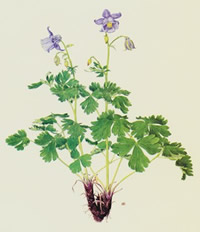Aquilegia nuragica
| Aquilegia nuragica | |
|---|---|

| |
| Botanical illustration of Aquilegia nuragica | |
| Scientific classification | |
| Kingdom: | Plantae |
| Clade: | Tracheophytes |
| Clade: | Angiosperms |
| Clade: | Eudicots |
| Order: | Ranunculales |
| Family: | Ranunculaceae |
| Genus: | Aquilegia |
| Species: | A. nuragica
|
| Binomial name | |
| Aquilegia nuragica | |
Aquilegia nuragica, commonly called Nuragica columbine,[3] is a perennial flowering plant in the family Ranunculaceae. It is endemic to Italy, in a single canyon in the Supramonte mountain range on the island of Sardinia.[1]
Description
[edit]Aquilegia nuragica has a single, scarcely branching vertical stem of 20–45 cm (7.9–17.7 in) in height, smooth at the bottom and covered with fine hairs or glands further up. The basal leaves have hairless stalks 12–25 cm (4.7–9.8 in) long, each division of which creates a set of three stalks. The leaflets consist of three segments with pointed teeth on the outer edge (contrasting with the closely related Sardinian species Aquilegia barbaricina, which has more rounded teeth). The plant produces three to five nodding, pale blue or white flowers 25–30 mm (0.98–1.18 in) across, consisting of five fused petals with ending in a hooked nectar spur. The fruit is a hooked, drop-shaped capsule.[4]
Taxonomy
[edit]The species forms a monophyletic clade with the other columbine species endemic to Corsica and Sardinia, Aquilegia barbaricina, Aquilegia bernardii, Aquilegia litardierei, and Aquilegia nugorensis.[5] However, it is clearly genetically isolated from the other Sardinian species.[4]
Etymology
[edit]The specific epithet nuragica means "Nuragic" in Latin and Italian, referring to the Nuragic civilization that flourished on Sardinia in the Bronze Age.
Distribution and habitat
[edit]Aquilegia nuragica is only found in one area of about 50 m2 (540 sq ft) at Gorropu, near Urzulei.[4] It grows on the nearly vertical limestone cliffs at altitudes of 620–680 m (2,030–2,230 ft),[6] in a gorge along the seasonal Flumineddu River. It can occasionally be found on the sandy pebble substrate of the riverbed due to seeds being dispersed from the cliff, although these specimens are regularly washed away by floods.[4]
Conservation
[edit]Aquilegia nuragica is an IUCN Red List Critically Endangered plant species and IUCN Top 50 Campaign Mediterranean Island Plants, threatened by habitat loss. The population is very small, with only 10–15 individuals believed to exist.[1]
The decline in the plant's population seems to be due to natural factors. However, due to the inaccessibility of the site, it is difficult to research the decline. It is not affected by grazing due to the plant's toxicity.[1]
The species is currently not under any legal protection. Despite occurring within the Gennargentu National Park, the lack of a management committee means no effective preservation measures are in place.[4]
Ecology
[edit]The natural habitat of Aquilegia nuragica is in Mediterranean shrubby vegetation.[1]
References
[edit]- ^ a b c d e Camarda, I. (2006). "Aquilegia nuragica". IUCN Red List of Threatened Species. 2006: e.T61672A12520091. doi:10.2305/IUCN.UK.2006.RLTS.T61672A12520091.en. Retrieved 17 November 2024.
- ^ "Aquilegia nuragica Arrigoni & E.Nardi". Plants of the World Online. Royal Botanic Gardens, Kew. Retrieved 17 November 2024.
- ^ "Aquilegia nuragica Nuragica Columbine". World Plants. Retrieved 5 September 2020.
- ^ a b c d e "The Top 50 Mediterranean Island Plants: Wild plants at the brink of extinction, and what is needed to save them" (PDF). IUCN. Retrieved 17 November 2024.
- ^ Fior, Simone; Li, Mingai; Oxelman, Bengt; Viola, Roberto; Hodges, Scott A.; Ometto, Lino; Varotto, Claudio (2013). "Spatiotemporal reconstruction of the Aquilegia rapid radiation through next-generation sequencing of rapidly evolving cpDNA regions". New Phytologist. 198 (2): 579–592. doi:10.1111/nph.12163. PMID 23379348.
- ^ Fenu, G.; Mattana, E.; Congiu, A.; Garrido, J. L.; Bacchetta, G. (2011). "Aquilegia nuragica Arrigoni & E. Nardi" (PDF). Informatore Botanico Italiano. 43 (2): 392–394.
External links
[edit] Media related to Aquilegia nuragica at Wikimedia Commons
Media related to Aquilegia nuragica at Wikimedia Commons


